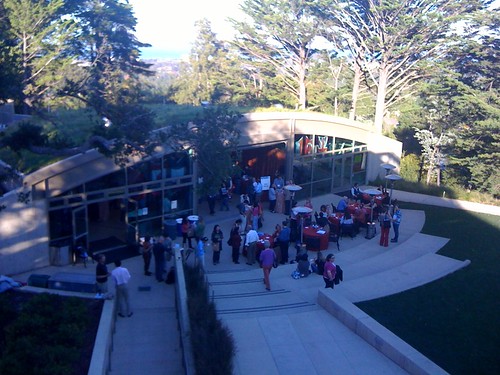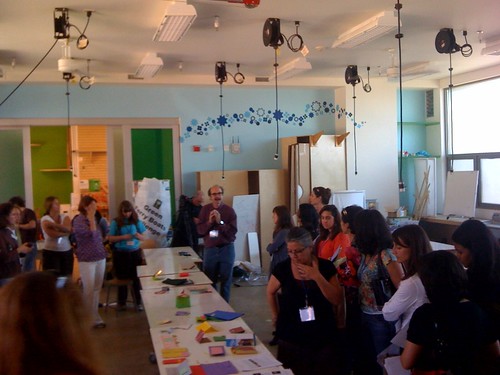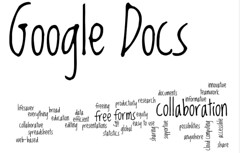Well, it has been almost 4 full months since my school fully transitioned away from the Firstclass email system to the
Google Apps for Education suite. In a series of posts over the next few weeks I'm going to share what we did well and what we wish we could do over. Today I'm going to start with what we did well during our transition (not to gloat, but we did do many things well, hence the ridiculously long post). As a side, I want to say that I'm incredibly impressed by how our users are making use of this network so far. We have some faculty and staff members piloting the use of ePortfolios with Google Sites and many other wonderful things going on as well. For seven years I worked at a school that used Microsoft Exchange and last year I used Firstclass at Castilleja. Without any hesitation, I can say that Google Apps smokes both of these platforms in terms of easy of use and collaboration potential (note how I didn't even mention anything about Google Apps being free and these other platforms costing a serious amount of money in terms of annual licensing, hardware, and IT staffing/management ;-)
Things we did well in our move to Google Apps for Education:
1. Youth helpers - We solicited the assistance of our students before, during, and after our June 15th, 2009 cut date and they were a tremendous help. In April we asked interested high school students to serve as "early adopters" of the new system. A handful agreed to transition to the system early and their participation was key. Some of these students even configured their mobile devices to access mail which they really appreciated. These early adopters gave us feedback and helped us tune and further customize our support materials that would be critical during the larger roll out.
We also had one of our student summer tech department interns create a
series of screencasts to help support students throughout the transition. Ultimately these screencasts turned out to be more helpful to our faculty and staff members. Screencasts in general have been of immense value in getting the word out and providing support materials to our users.
2. Faculty and Staff Early Adopters - In addition to asking students to be early adopters, we also asked our faculty and staff to join in as early adopters last April and May. Once again, having these early adopters in the new space and providing feedback to us turned out to be immensely valuable on many different levels. We created weekly
"Early Adopter Newsletters" for the 20 or so early adopters. This newsletter series helped keep people updated on our progress with the overall transition.
3. Transition Support Site - We created a transition support site that served as a repository for our support docs, tutorials, screencasts, etc. I'm not sure how many people used this site, but to this day is has served as a nice little portfolio of our transition. I'm glad we "ate our own dogfood" and used a Google Site to manage and organize these support members. Dave Girouard, who manages Google's Enterprise business worldwide, actually commented on our transition site in
this Twitter post.
4. Faculty and Staff Transition Support Team - We created a support team of roughly 8 faculty and staff members who helped in many ways with our transition. In addition to creating support tutorials and attending a few meetings to help prepare the community for the move, they also contributed to a series of workshops we offered for our school community in late August. I greatly appreciate the hard work and contributions of all who participated on this team.
5. Workshops - Speaking of workshops, these turned out to be incredibly helpful for many of our staff and faculty members. We offered one on June 16th and three in late August. We basically went through each component of the network (mail, sites, calendar, doc sharing) in these workshops. They were each about 2 hours in length and participants were quite appreciative of these learning opportunities.
6. Faculty and Staff Dashboard Start Page - Thanks to the outstanding work of our Director of Technology,
Steve Taffee, we have an awesome faculty and staff start page/dashboard. Google Apps networks certainly can be a bit messy when you first start out, and having folks set something like this as their home page can really simply information access for your folks.
Here is a screenshot of what ours looks like (this dashboard was created with google sites and is permissioned to be visible only by users who have authenticated to the network). We created a dashboard start page for students too, but so far most of them don't really use it.
7. Activating most/all of the services - We activated pretty much all of the services for our student, staff and faculty users. This includes mail, sites, docs, contacts and contact sharing, mobile/cell phone access, calendar, and chat. We enabled other services including a custom URL generator (kinda like tinyurl) and Google's Moderator platform as well, but for some reason we can't configure our DNS internally to get these tools to work inside of the school's LAN. We also checked an option in the control panel that allows new labs and features to be available to users in our network. This gives our faculty, staff and students access to an ever evolving, powerful set of applications that allow them to collaborate, share and communicate in ways we couldn't have imagined even a few years ago. Our users love the gmail themes and labs. It is my belief that if you make powerful tools available to people and expect that they will do creative and powerful things, they will rise to the occasion (alternately, if you lock things down because you're afraid users might do something bad, they will engage you in an unending cat and mouse game that you cannot win). I'm glad to be at a school where we have liberal user policies that demonstrate trust and faith in our community members.
8. Custom login page - This was created by the handy work of our system engineer, Adam Contois (no, you can't hire him--in addition to his excellent work with python and the custom apps he has built for our google network, he is needed to push mobile lab carts around our campus ;-)
You may view our login page here. Along with providing a school branded login point to these services, Adam also configured this application to allow administrators to sign in as other users (I believe this was all managed and configured with the Google OAUTH API). Being able to sign in as other users to help support is absoultely INVALUABLE. We did have Adam join us on the Edtech Brainstorm at
Edtechtalk.com in June of 2009 to talk a little bit about some of the cool customizations he built for our network. Listen to the recorded audio from
this conversation online here. Adam likes a good challenge and his work with our Google network and the other academic learning systems that we have in place (Linux lab, Moodle, Open Source client software deployment, etc) is greatly appreciated!
9. Research and development - We worked extremely hard on R and D with this network all of last year. Last year we activated the docs sharing component of the network and the students and teachers who used this really liked it (especially for things like collaborative scripts for movies, podcasts, etc). A year of using the network for document collaboration only really helped us learn the ins and outs of the system. We also spent time researching integration with Moodle and building our custom login page and experiementing with OAUTH. We dabbled with LDAP user directory integration, but at the end of the day we deciced not to enable this as our LDAP system wasn't in the best shape. Speaking of Moodle and Google, we were pretty psyched about the possibility for using this, but at the end of the day we decided not to go this route because we didn't want our non-teaching staff members to access their mail by going through Moodle. We also didn't want a scenario where access to mail became dependent on our Moodle network...we figured that Google's uptime would be better than our own Moodle network. But we still do think it is pretty cool that users could authenticate into moodle and then easily access the Google network from the google apps block in Moodle.
10. Development of a "pilot google apps network." In order to do much of the aforementioned R&D, we setup a "pilot" Google Apps network (the domain was "pilot.castilleja.org.") This allowed us a sandbox space to test, evaluate, play, explore, destroy, and discover new things. Google allows you to do this free of charge and I recommend to any organization who might be transitioning to Google to deploy a pilot network.
11. Networking and sharing - We spoke with people all over the place via telephone, social networks, etc. We linked up with several other independent schools who were thinking about transitioning away from Firstclass to Google Apps and we
shared ideas in an online forum. We even hosted a
webcast at one point to discuss strategies. We spoke with the lead IT manager at UW-Madison's Alumni network. UW-Madison had just shifted their mail services away from some proprietary application to Gmail and his advice and sharing of experiences was very helpful (I can't find his name, but when I do I will update this post).
12. Conference calls with our transition support reps from Google Education, Cindy and Austin, were extremely helpful as well. Google gives away transition support for free...this basically means that they dedicate a representative who is available via email, phone, google voice, etc up until you flip the switch and actually transition. They were extremely helpful in providing us with documents and suggestions to help ensure a smooth transition. We had basic questions regarding data ownership, reliability, data mining, advertising, security, etc-before we got too far along in the process we had answers to these questions-it is important that you do the same because people in your organization who are skeptical about outsourcing email will ask these questions and may event try to to spread FUD (Fear, Uncertainty and Doubt). We aggregated much of the documentation and answers to our questions from google early in this process over at
this wiki.
13. Installation of a Moodle virtual learning network to work in tandem with Google Apps. We installed Moodle at the beginning of the 2008-2009 network for faculty members who want a true virtual instructional environment that allows for assignment submission and grading. I mentioned above that we decided against the full google-moodle integration, but even having Moodle available for our teachers to use has been great.
14. Enabling of Postini Spam Services - Right now google is giving away Postini spam services free of charge. When we switched to Gmail we did see a fair amount of spam slipping through Google's basic spam service. After enabling Postini, this ended.
15. Student user name method -We used the last two digits of student graduation years + first initial + last name for student user names in the network. This means that Sara Smith from the class of 2020 would have a username of 20ssmith. This has made it really easy for administration, searching for students in the network, building contact lists, handling conflicts with users having the same name, etc.
16. Enabling mobile access for all users - I mentioned that we enabled almost all possible services above, but mobile services have been great thus far. Many of our users, including students, are configuring their various mobile devices to access their information in the network.
17. Transparency - We were transparent from the very beginning when we were floating the idea about possibly switching from Firstclass. We talked about this at committee meetings, with student groups, and we gave separate presentations at our all-faculty and all-staff meetings last spring. Our
Transition Support site was, from the first day, made available on the open web and wasn't closed in any way. Throughout the process we solicited suggestions and feedback. By the time the final decision was made by our administrative leadership team, we had the support of the overwhelming majority of our school community. We even recorded our
proposal presentation to our faculty and posted it for those who couldn't be in attendance. I feel as though by being direct and transparent we were able to build some positive mojo for this move.
 October 29th will mark the one year anniversary of our first live broadcast when our high school student webcasters were joined by colleague and friend, Doug Symington, to talk about political topics in the context of the 2008 US presidential election (our first show with Doug is archived and posted online here). Many of you know that I am a school technology coordinator and that one of the projects I've been involved in is helping our students to create their own live, student operated Internet radio station known as the Gator Radio Experience.
October 29th will mark the one year anniversary of our first live broadcast when our high school student webcasters were joined by colleague and friend, Doug Symington, to talk about political topics in the context of the 2008 US presidential election (our first show with Doug is archived and posted online here). Many of you know that I am a school technology coordinator and that one of the projects I've been involved in is helping our students to create their own live, student operated Internet radio station known as the Gator Radio Experience.![Reblog this post [with Zemanta]](http://img.zemanta.com/reblog_e.png?x-id=902ea9c2-6f89-4be2-a65b-5ebe04a16e50)
![Reblog this post [with Zemanta]](http://img.zemanta.com/reblog_e.png?x-id=692fef17-be4c-40bb-b056-e81b894ba80b)




![Reblog this post [with Zemanta]](http://img.zemanta.com/reblog_e.png?x-id=3738e21e-06d0-4253-bda9-5669ae16db19)

![Reblog this post [with Zemanta]](http://img.zemanta.com/reblog_e.png?x-id=7cd09b01-05f3-42c3-a694-ce3be6111d26)

![Reblog this post [with Zemanta]](http://img.zemanta.com/reblog_e.png?x-id=b95fdfd6-442c-4408-a8aa-cb456b028f98)

![Reblog this post [with Zemanta]](http://img.zemanta.com/reblog_e.png?x-id=50540fe2-8393-4195-8c1c-cdb0bb8450f1)